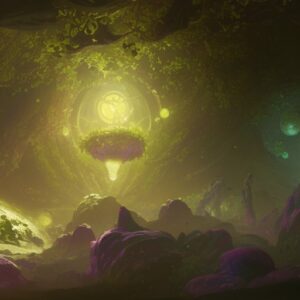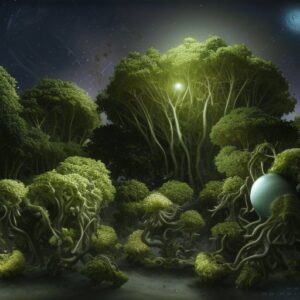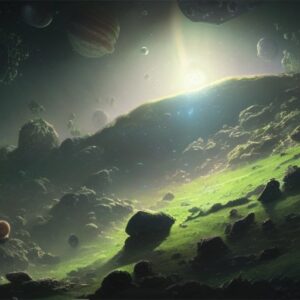
Exoplanet flora might seem like a sci-fi fantasy, but in reality, it’s a very real possibility. By exploring the galaxy, we can potentially discover new and delicious alien plants to add to our diets. However, just because something is edible doesn’t mean it’s safe, and we must carefully consider the potential risks and benefits of consuming alien plants. From determining nutritional content to evaluating potential toxicity, there’s much to consider. Yet, the opportunity to expand our culinary horizons and explore new flavors is tantalizing. In this article, we’ll delve into the science of edibility and explore the potential for safely consuming exoplanet flora.
I. Introduction
Ladies and gentlemen, fellow space cadets, and extraterrestrial enthusiasts, it’s time for us to embark on an otherworldly adventure. As we soar through the galaxy, we’ll be keeping our eyes peeled for more than just breathtaking views of the cosmos and new planets to explore. Our mission? To discover, taste, and possibly even snack on the edible flora that could be waiting for us on distant exoplanets.

Yes, you heard that right, folks. We’re talking about alien salads and extraterrestrial snacks, the kind that could add some much-needed variety to our earthly diets. So, join us on this journey of taste exploration as we ponder the possibilities of consuming plants from another world.
Now, we know what you might be thinking. Is this some kind of joke? Are we really talking about eating alien plants? But let’s not be too quick to judge, folks. After all, it wasn’t that long ago that sushi was considered a bizarre and perhaps even dangerous food item for many people. And now, it’s enjoyed by millions around the world.
Who knows what kind of exotic flavors and nutritional benefits we could discover from eating exoplanet flora? One thing’s for sure, the possibilities are enough to make our mouths water. Perhaps we’ll find a juicy fruit that tastes like a cross between a strawberry and a mango. Maybe we’ll discover a leafy green that packs more vitamins than any vegetable on earth. The possibilities are endless.
But before we get too carried away, let’s acknowledge that eating plants from another planet is no small feat. There are countless safety concerns and ethical considerations to take into account. From identifying potential toxins to evaluating its impact on indigenous life forms, exploring the edibility of exoplanet flora is no easy task.
That said, with new advancements in technology and ongoing exploration of the cosmos, we’re closer than ever to discovering new literally out-of-this-world foods to satiate our appetites. So, get ready to strap on your space helmets, fire up the warp drives, and prepare to discover the ultimate cosmic cuisine.
II. The Science of Edibility
Now that we’ve got our appetites sufficiently whetted, let’s take a look at the science behind determining what makes a particular plant safe to eat. While the good folks at the FDA may have their own standards for what’s considered “edible,” it’s important to note that they’re not exactly intergalactic experts.

So, what do we look for when evaluating the edibility of exoplanet flora? For starters, taste is a critical factor. After all, if the food doesn’t taste good, who wants to eat it, right? But taste alone isn’t enough; we also must consider what kind of nutritional value these alien plants offer. Could they possibly contain powerful antioxidants, essential vitamins or healing properties? The potential health benefits are mouth-watering on their own.
Of course, one of the biggest concerns when it comes to consuming alien plants is the potential for toxicity. We don’t want anyone ending up with a case of the space-squirts or worse, an alien food poisoning outbreak on our hands. That’s why extensive laboratory tests are necessary to ensure the safety of any new food source.
However, the process of evaluating exoplanet flora for edibility is no simple task. It can take years, even decades, to determine the levels of nutrients, toxins, and other factors that determine whether a plant is safe to consume. And all that bureaucracy and red tape of getting FDA approval, sheesh!
But here’s the thing, who says we have to wait for government approval or scientific validation to chow down on some alien salads? For all we know, these extraterrestrial treats could be the next big culinary trend, with adventurous eaters flocking from across the galaxy to sample the latest in intergalactic cuisine.
So there you have it, my fellow space chefs. The science of edibility might not be easy, but with a little creativity, boldness, and risk-taking attitude, we can start our very own cosmic culinary revolution. After all, who knows what kind of delicious secrets the universe has hidden for us to discover?
III. Eating Across the Galaxy
Now that we’ve established that eating exoplanet flora is a possibility, it’s time to take a closer look at some of the plant species that have been discovered across the galaxy. From the acidic soils of Alpha Centauri to the icy plains of Andromeda, there’s plenty of flora to excite our taste buds and blow our minds.

First up, we have the burjito plant, which was discovered on a planet orbiting a nearby red dwarf star. This succulent plant has a texture similar to that of a cactus, but with a juicy, sweet flavor that is reminiscent of a pear. It can also be fermented and distilled to make a potent, tequila-like drink that is a favorite among the local alien population.
Next, we have the icy lichen found on a dwarf planet in the Milky Way galaxy. Despite its cold habitat, this lichen has a delightfully refreshing flavor that is similar to spearmint, making it a popular ingredient in intergalactic breath mints. It can also be used to flavor tea and other hot beverages, providing a warm contrast to its chilly origins.
Moving on to a planet in the neighboring Andromeda galaxy, we have the fiery-hot flamingo fruit. This pink fruit has a tough outer layer and a soft, juicy interior that packs a serious punch of spice. It is often used as a condiment in spicy dishes, and is a favorite of daring eaters and spice enthusiasts alike.
Last but not least, we have the multi-colored starfruit from a planet in the outer regions of the galaxy. This beautiful fruit has a unique texture that is both crunchy and chewy, and its sweet and tangy flavor makes it a popular ingredient in salads and desserts. It also happens to glow in the dark, making it a must-have for any futuristic feast or rave.
These are just a few of the edible flora that have been discovered across the galaxy, and who knows what other surprises await us in the reaches of space. At the end of the day, one thing’s for certain: getting a taste of the culinary delights of exoplanets is sure to be some out-of-this-world adventure that will send our taste buds into hyperspace.
IV. The Pros and Cons of Eating Exoplanet Flora
As much as we’d all love to indulge in extraterrestrial smoothies and alien salads, we must acknowledge the potential risks of consuming exoplanet flora. First and foremost, there is the concern of toxicity. After all, we don’t know what kind of chemicals and compounds could be lurking beneath the surface of these exotic plants. The last thing we want is to discover that an alien fruit we thought was harmless makes us break out in a terrible rash or worse, turns us into space zombies.

Another issue is the potential impact on the ecosystem of the exoplanet. Who knows what kind of unintended consequences our consumption of these alien plants could have on the local ecology. We might inadvertently introduce a foreign plant species that quickly takes over and upsets the balance of nature. Or, worse yet, we might upset some intergalactic biodiversity balance and cause a ripple effect felt across the galaxy.
But, let’s not be too quick to write off the benefits of discovering and consuming exoplanet flora. For one thing, we could discover a whole new range of delicious and nutritious foods that could be vital to sustaining long-term space travel. Just think of all the space rations we’ve been subsisting on for far too long. Variety may very well be the spice of life, even for space travelers.
Furthermore, alien plants could provide a wealth of unique medicinal benefits. Who knows what kind of compounds and nutrients are waiting for us? After all, some of the most effective drugs on Earth come from the natural world. It’s not hard to imagine some new pharmaceutical marvels waiting for us in the cosmos.
V. The Future of Alien Agriculture
As we continue our interstellar culinary explorations, we can’t help but wonder about the future of alien agriculture. After all, if we’re going to make a habit out of consuming extraterrestrial fruits and veggies, we’re going to need to figure out how to grow them ourselves.

Enter space farming, the practice of cultivating crops in space and on other planets. Could this be the key to sustainable food sources for future space travelers and colonizers? It’s definitely a possibility, as we continue to develop the technology necessary for both terraforming planets and growing crops in hostile environments.
Imagine a future where we have interstellar farmers’ markets, selling exotic produce from faraway galaxies. Perhaps we’ll be growing kale on Mars or cultivating oranges on a distant moon. The possibilities are as endless as the universe itself.
Of course, there are many challenges to overcome before we can make space farming a reality. We’ll need to engineer plants that can withstand harsh radiation and extreme temperatures. We’ll also need to develop new methods for irrigation and nutrient delivery in low-gravity environments. And let’s not forget the challenges of transporting large amounts of soil and equipment to far-off planets.
But as pioneers of space exploration, we’ve never been ones to shy away from a challenge. With the right combination of ambition, ingenuity, and technology, we could be on the verge of a new era of agriculture, one that reaches beyond the limits of our own planet. So, as we continue to venture into the great unknown, let’s not forget about the role that cosmic cuisine could play in shaping our future society. Who knows where our interstellar culinary endeavors will take us next? The possibilities are truly out of this world.
VI. Conclusion
As we reach the end of our journey through the cosmos of culinary delights, it’s time to take a final bite out of our exploration of exoplanet flora. While the potential for discovering new and tasty alien plants is certainly tantalizing, we mustn’t overlook the potential risks and ethical considerations involved.

From the impact on native ecosystems to the possibility of unknown toxins, there’s a lot to consider when it comes to consuming exoplanet flora. However, if we approach the exploration of these new foods with caution and an eye towards sustainability, we just might be able to add some incredible new flavors to our intergalactic menu.
Who knows, one day we might just find ourselves beaming up some tasty lettuce from a faraway planet for our interstellar salad. But until then, let us continue to explore the grandeur and mystery of the universe with an open mind and a healthy appetite for adventure.
With each new discovery, we’re reminded of just how vast and awe-inspiring the universe truly is. So, let us savor our earthly foods while keeping one eye on the stars, ready to embark on the next voyage of culinary discovery whenever and wherever it may come.
Thank you for joining us on this journey through the edibility of exoplanet flora. May your explorations be delicious and your adventures out of this world.






